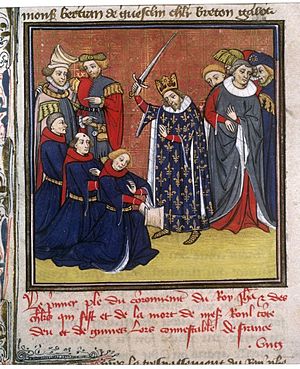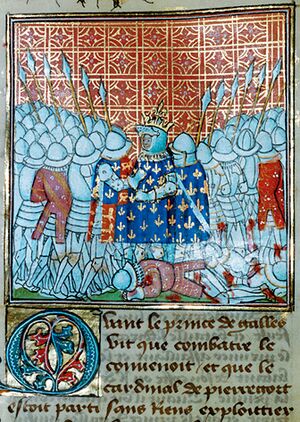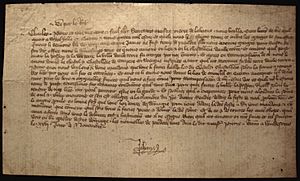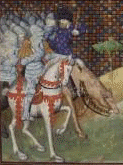Ransom of John II of France facts for kids
The ransom of John II of France was a big event during the Hundred Years' War. This war was fought between France and England. King John was captured by the English in 1356 at the Battle of Poitiers. The English crown then held him for a large sum of money, called a ransom. This ransom was finally agreed upon in the Treaty of Brétigny in 1360. King John II's capture and ransom caused many problems for France and helped England gain more power during the war.
Why it Happened
King John II became king in 1350. Even before his capture in 1356, his rule was full of problems. There were tensions inside France and with other countries. Both Charles II of Navarre and Edward III of England believed they had a right to rule French lands. Important areas like Normandy acted almost like their own countries. They often had their own small wars. Many French nobles felt more loyal to the English king than to Paris.
The Hundred Years' War had started 19 years earlier. It wasn't like modern wars between whole nations. Instead, it was a series of fights. England often had help from people in Burgundy and Gascony. It was even like a civil war at times, with people fighting who shared some of the same history.
France had lost badly at the Battle of Crécy under John's father, Philip VI of France. They also lost the city of Calais. This made it even more important for the Valois family (John's family) to win battles. King John himself wasn't a typical warrior. He wasn't very strong and didn't often joust or hunt. He preferred books, art, and music.
Perhaps because he wasn't a great fighter, John created the Order of the Star. Like Edward III's Order of the Garter, John hoped to use the idea of knightly chivalry to make himself seem more powerful. John had grown up around secrets and betrayal. So, he ruled in a very private way. He only trusted a few close advisors. This often made his nobles angry. They felt he was unfair and promoted people who didn't deserve it. These problems within the French nobility and John's way of ruling would play a big part in his ransom.
King John is Captured
The war started again in 1355 after an eight-year break. Both kingdoms were having money problems. The terrible Black Death had also happened. King John tried to make peace by offering land in France. But Edward III knew peace wouldn't last.
In September 1355, Edward, The Black Prince, led an English army on a destructive raid. This was called a chevauchée, and it went across southwestern France. King John stopped an English attack in Normandy. Then, in September 1356, he led a French army of about 16,000 soldiers south. They crossed the Loire to try and outsmart the English. The English had fewer than 7,000 soldiers near Poitiers.
The Black Prince's army was in a bad spot. They were trapped, outnumbered, and many were sick. King John felt sure he would win. He refused the Prince's offers to talk things over. John demanded the Prince surrender as a prisoner. He also ignored advice to surround the Prince and starve him out. Instead, the King ordered a direct attack. In those days, knights wanted to show off their bravery in battle. Winning was also seen as a sign of God's favor. So, a big battle seemed like a good idea for the King.
The Battle of Poitiers was a disaster for France. The English had a better defensive position and strategy. This allowed them to use their longbows very well. Like the Battle of Agincourt 60 years later, many French soldiers did not fully fight. The Dauphin Charles and his younger brother Louis left the battle early. King John might have ordered them to leave. At least they avoided being captured. King John was not so lucky.
John had tried to avoid capture. He was guarded by 90 members of the Order of the Star. He also had 19 knights from his personal guard dress just like him to confuse the enemy. But he was surrounded, and most of his Order were dead. The King fought bravely until Denis de Morbecque, a French exile fighting for England, came up to him.
"Sir," Morbecque supposedly said, "I am a knight from Artois. Give yourself up to me, and I will take you to the Prince of Wales."
King John is said to have surrendered by giving him his glove. That night, King John ate dinner in the Black Prince's red silk tent. The Black Prince personally looked after him. John was then taken to Bordeaux, and from there to England. He was held in different places, including the Savoy Palace, Windsor, and eventually the Tower of London.
As a prisoner, John was given special royal treatment. He could travel and live like a king. His records show he bought horses, pets, and clothes. He even had an astrologer and a court band. Philip, John's fourth son, was also captured at Poitiers and stayed with him.
The Ransom Demands
Now that King John was held by the English, he had to try and make a peace treaty. This would likely mean paying a huge ransom and giving up French land. Meanwhile, in Paris, the Dauphin, Prince Charles, was having his own problems. He was now the regent, ruling in his father's place. Charles had returned to Paris without being captured, but people were very angry about France's second big military loss.
Charles called a meeting of the Estates General in October. He needed money to defend the country. But many people there were furious about how King John had managed things. They formed a group led by Etienne Marcel, a powerful merchant leader. Marcel demanded big changes to how the government worked. Charles refused, sent the Estates-General home, and left Paris.
Political fighting continued. Charles tried to make money by lowering the value of the currency. Marcel ordered strikes, and Charles had to cancel his plans. He called the Estates back in February 1357. The common people, with support from many nobles, gave Charles a list of 61 rules. This was called the Grand Ordinance. It would have greatly limited the king's power. Under pressure, Charles signed it as Regent. But when King John, still a prisoner in Bordeaux, heard about it, he immediately said it was not valid.
During the summer, Charles started to get support from other parts of France against Marcel and the people of Paris. He successfully returned to Paris. The final act of violence was when the angry crowd murdered important royal officials. Charles fled the capital again. But this attack broke the temporary alliance between the common people of Paris and the nobles. By August 1358, Marcel was dead. Charles was able to return to Paris once more.
The Pope helped arrange a truce in March 1357. Talks began for King John's release. Once in London, King John signed the Treaty of London (1358). This treaty set his ransom at 4 million écus (a type of coin). France could not pay the first part of the ransom. So, this treaty was replaced with the Treaty of London (1359). This new treaty also gave most of western France to England.
The Estates General rejected this second treaty. So, King Edward invaded France again later that year. He landed in Calais in October 1359. Edward reached Reims in December and Paris in March. But his attacks did not make the French army come out for a big battle. King Edward then lowered his demands. He asked for a third of western France (mostly in Aquitaine and Gascony) and a ransom of 3 million crowns. This was agreed to in the Treaty of Brétigny in 1360.
King John's Return
The Treaty of Brétigny was signed on May 25, 1360. It offered John's release in exchange for 83 hostages and other payments. After four years as a prisoner, King John was set free. John's son, Prince Louis, who had avoided capture at Poitiers, was one of the hostages. In October 1360, Louis sailed to England from Calais.
The full ransom was supposed to be paid within six months. But France was weak financially and could not pay on time. After several years in captivity, Louis tried to secretly talk with Edward III of England to get his freedom. When this failed, Louis decided to escape. He arrived back in France in July 1363.
King John returned to a difficult situation in 1360. France was still divided. It had lost a lot of land and owed a lot of money to England. The Dauphin's baby daughters died within two weeks of each other. Charles himself had been very sick. His hair and nails fell out. Some people think he had been poisoned. Most of his closest advisors had died at the Battle of Poitiers.
The royal government continued to have problems. When John heard that Louis had escaped, he decided to go back to captivity in England. John's advisors tried to stop him. But he insisted, saying it was about "good faith and honor." He sailed to England that winter. He was welcomed warmly in London in January 1364. However, John became ill and died in April 1364. His body was returned to France. He was buried in the royal tombs at Saint Denis Basilica.
It's not completely clear why John returned to captivity. Chivalry was very important at that time. Acts of kindness were seen as good. But breaking the code of chivalry was often forgotten if it helped the country. Escaping from captivity was not chivalrous, and it had consequences. But it still happened often. John's critics said he returned to London for "fun" because he didn't live like a warrior. Historians have guessed that John simply couldn't face the problems of ruling France. John might have seen his failures and Charles's bad luck as a sign from God. So, he might have wanted to make up for it. John might also have hoped to talk directly with Edward III.
Over time, King John's ransom had a big impact. The money paid to England helped the English royal treasury for many years. Even though King Charles V had a successful short reign, the political problems after King John's capture led to more instability. This weakened France through much of the Hundred Years' War.
|





